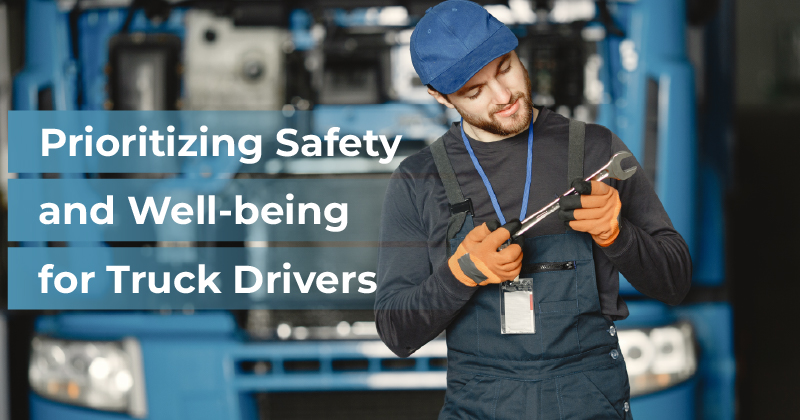
Truck driving, a profession that keeps the wheels of our economy turning, is challenging. Picture this: a lone driver, miles away from home, navigating endless highways under the blazing sun or through the darkness of night. It’s a demanding job with long working hours, extended periods away from loved ones, and the constant pressure to meet tight schedules. But beneath the surface, there’s an issue that deserves our utmost attention – the safety and well-being of truck drivers.
In this blog, we’ll dive deep into the challenges faced by truck drivers, explore the pivotal role of the 2020 Hours of Service (HOS) rules in enhancing their safety, and provide valuable insights and resources to help these dedicated professionals prioritize their well-being. We’ll also take a moment to highlight how TMS-Digital, a premier trucking solutions and software provider, has been at the forefront of emphasizing driver safety.
The Demands of the Job
Truck driving, often glamorized on the surface, is a grueling profession. Long hours behind the wheel, weeks on the road, and limited opportunities for rest take their toll. These demands can lead to physical and mental health issues, including fatigue, sleep disorders, and stress.
The Challenges Faced by Truck Drivers
Truck drivers are the backbone of our nation’s logistics network, transporting goods from coast to coast, ensuring store shelves are stocked and industries keep running. However, the life of a truck driver is far from easy. The challenges they face daily are both physically and mentally taxing.
- Long Hours and Time Away from Home: One of the most significant challenges is the long working hours. Truck drivers often spend extended periods on the road, away from their families and homes. The isolation and solitude can lead to feelings of loneliness and homesickness.
- Physical Demands: Hours spent behind the wheel can affect a driver’s physical health. Prolonged sitting, coupled with limited opportunities for exercise, can result in various health issues, including obesity and back problems. These physical challenges are exacerbated by the need to load and unload cargo, often involving heavy lifting and strenuous physical activity.
- Mental Health Struggles: The solitary nature of truck driving can also lead to mental health issues, such as depression and anxiety. The constant pressure to meet delivery schedules, navigate traffic, and deal with unpredictable weather adds to the stress.
- Fatigue and Sleep Disorders: Irregular working hours and the need to drive through the night disrupt natural sleep patterns. This can result in fatigue and sleep disorders, which impair a driver’s alertness and decision-making abilities. Fatigue is a significant contributor to accidents on the road.
 The Road to Safety
The Road to Safety
Safety is paramount in the world of truck driving. Truck drivers are the lifeblood of our supply chain, and their safety directly impacts us all. Introducing the 2020 Hours of Service (HOS) rules – a game-changer for the industry. These regulations have significantly improved road safety by mandating essential breaks and rest periods. Learn how the HOS rules have reshaped the trucking landscape and made it safer for drivers and other road users.
The Pivotal Role of the 2020 Hours of Service (HOS) Rules in Enhancing Their Safety
The safety of truck drivers and everyone sharing the road with them is of paramount importance. In 2020, significant changes were made to the Hours of Service (HOS) rules, and these changes have played a pivotal role in improving the safety of truck drivers:
Introducing Mandatory 30-Minute Rest Breaks: The revised HOS rules now require truck drivers to take a mandatory 30-minute rest break after driving for a certain period. This break ensures drivers have time to rest and recharge, reducing the risk of fatigue-related accidents.
Sleeper Berth Provision: The new HOS rules also provide more flexibility for drivers by allowing them to split their required 10-hour rest time into two periods. This sleeper berth provision enables drivers to rest when they feel most fatigued, improving their overall well-being and safety.
Reducing Pressure to Drive During Adverse Conditions: The HOS rules also address concerns related to driving during adverse conditions. Drivers are no longer compelled to drive in dangerous weather or traffic conditions to meet strict schedules, reducing the risk of accidents caused by external factors.
Prioritizing Well-being
Life on the open road as a truck driver is an adventure but comes with challenges. To maintain your well-being while on the road, here are four key areas to focus on:
- Managing Fatigue: Plan your routes strategically, take breaks when needed, stay hydrated, and incorporate simple exercises into your routine.
- Maintaining a Healthy Lifestyle: Prioritize nutritious food options, even when choices are limited. Keep your energy levels stable with balanced meals and snacks. Find ways to stay active during rest stops.
- Staying Connected: Don’t let the road isolate you. Use technology to communicate with loved ones regularly. Their emotional support can boost your mental well-being.
- Resources for Support: Explore support hotlines, online communities, and dedicated apps designed to help you manage both physical and mental health on the road.
Prioritizing your well-being is essential to enjoy the journey and safely navigate the highways. Your health matters; these steps can make a meaningful difference as a truck driver.
Highlighting TMS-Digital’s Commitment to Safety
At this juncture, it’s essential to spotlight TMS-Digital, a leading trucking solutions and software provider. With a steadfast commitment to driver safety, TMS-Digital has consistently emphasized the well-being of truck drivers. Their innovative solutions and technologies are designed to streamline operations and ensure the safety and comfort of those behind the wheel.
Conclusion
In closing, the safety and well-being of truck drivers are paramount. This blog has explored their challenges, celebrated the positive changes brought by the HOS rules, and provided actionable insights to help drivers prioritize their health. As we move forward, remember that every truck on the road represents the hard work and dedication of a driver striving for safety, well-being, and a better future.
Keep in touch with our blog section for more informative content on trucking and safety. Explore our related articles and resources to further deepen your understanding of this critical issue.
Together, let’s keep our roads safe and support the unsung heroes of the trucking industry – the truck drivers who keep our world moving.







